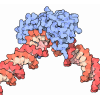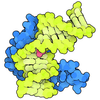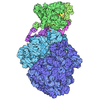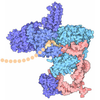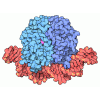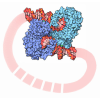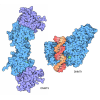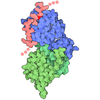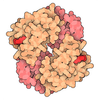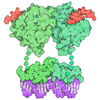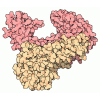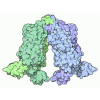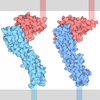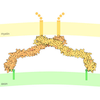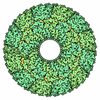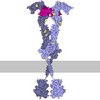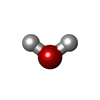Entry Database : PDB / ID : 4oi8Title RAGE is a nucleic acid receptor that promotes inflammatory responses to DNA. 5'-D(*CP*CP*AP*TP*GP*AP*CP*TP*GP*TP*AP*GP*GP*AP*AP*AP*CP*TP*CP*TP*AP*GP*A)-3'5'-D(*CP*TP*CP*TP*AP*GP*AP*GP*TP*TP*TP*CP*CP*TP*AP*CP*AP*GP*TP*CP*AP*TP*G)-3'Advanced glycosylation end product-specific receptor Keywords / / / / Function / homology Function Domain/homology Component
/ / / / / / / / / / / / / / / / / / / / / / / / / / / / / / / / / / / / / / / / / / / / / / / / / / / / / / / / / / / / / / / / / / / / / / / / / / / / / / / / / / / / / / / / / / / / / / / / / / / / / / / / / / / / Biological species Homo sapiens (human)Method / / / Resolution : 3.101 Å Authors Jin, T. / Jiang, J. / Xiao, T. Journal : J.Exp.Med. / Year : 2013Title : RAGE is a nucleic acid receptor that promotes inflammatory responses to DNA.Authors: Sirois, C.M. / Jin, T. / Miller, A.L. / Bertheloot, D. / Nakamura, H. / Horvath, G.L. / Mian, A. / Jiang, J. / Schrum, J. / Bossaller, L. / Pelka, K. / Garbi, N. / Brewah, Y. / Tian, J. / ... Authors : Sirois, C.M. / Jin, T. / Miller, A.L. / Bertheloot, D. / Nakamura, H. / Horvath, G.L. / Mian, A. / Jiang, J. / Schrum, J. / Bossaller, L. / Pelka, K. / Garbi, N. / Brewah, Y. / Tian, J. / Chang, C. / Chowdhury, P.S. / Sims, G.P. / Kolbeck, R. / Coyle, A.J. / Humbles, A.A. / Xiao, T.S. / Latz, E. History Deposition Jan 19, 2014 Deposition site / Processing site Supersession Apr 30, 2014 ID 3S59 Revision 1.0 Apr 30, 2014 Provider / Type Revision 1.1 Oct 16, 2024 Group / Database references / Structure summaryCategory chem_comp_atom / chem_comp_bond ... chem_comp_atom / chem_comp_bond / database_2 / pdbx_entry_details / pdbx_modification_feature / struct_ref_seq_dif Item / _database_2.pdbx_database_accession / _struct_ref_seq_dif.details
Show all Show less
 Yorodumi
Yorodumi Open data
Open data Basic information
Basic information Components
Components Keywords
Keywords Function and homology information
Function and homology information Homo sapiens (human)
Homo sapiens (human) X-RAY DIFFRACTION /
X-RAY DIFFRACTION /  SYNCHROTRON /
SYNCHROTRON /  MOLECULAR REPLACEMENT / Resolution: 3.101 Å
MOLECULAR REPLACEMENT / Resolution: 3.101 Å  Authors
Authors Citation
Citation Journal: J.Exp.Med. / Year: 2013
Journal: J.Exp.Med. / Year: 2013 Structure visualization
Structure visualization Molmil
Molmil Jmol/JSmol
Jmol/JSmol Downloads & links
Downloads & links Download
Download 4oi8.cif.gz
4oi8.cif.gz PDBx/mmCIF format
PDBx/mmCIF format pdb4oi8.ent.gz
pdb4oi8.ent.gz PDB format
PDB format 4oi8.json.gz
4oi8.json.gz PDBx/mmJSON format
PDBx/mmJSON format Other downloads
Other downloads 4oi8_validation.pdf.gz
4oi8_validation.pdf.gz wwPDB validaton report
wwPDB validaton report 4oi8_full_validation.pdf.gz
4oi8_full_validation.pdf.gz 4oi8_validation.xml.gz
4oi8_validation.xml.gz 4oi8_validation.cif.gz
4oi8_validation.cif.gz https://data.pdbj.org/pub/pdb/validation_reports/oi/4oi8
https://data.pdbj.org/pub/pdb/validation_reports/oi/4oi8 ftp://data.pdbj.org/pub/pdb/validation_reports/oi/4oi8
ftp://data.pdbj.org/pub/pdb/validation_reports/oi/4oi8 Links
Links Assembly
Assembly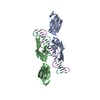
 Components
Components Homo sapiens (human) / Gene: AGER, RAGE / Production host:
Homo sapiens (human) / Gene: AGER, RAGE / Production host: 
 X-RAY DIFFRACTION / Number of used crystals: 1
X-RAY DIFFRACTION / Number of used crystals: 1  Sample preparation
Sample preparation SYNCHROTRON / Site:
SYNCHROTRON / Site:  APS
APS  / Beamline: 22-BM / Wavelength: 1.03 Å
/ Beamline: 22-BM / Wavelength: 1.03 Å Processing
Processing MOLECULAR REPLACEMENT / Resolution: 3.101→43.329 Å / σ(F): 1.36 / Phase error: 29.25 / Stereochemistry target values: TWIN_LSQ_F
MOLECULAR REPLACEMENT / Resolution: 3.101→43.329 Å / σ(F): 1.36 / Phase error: 29.25 / Stereochemistry target values: TWIN_LSQ_F Movie
Movie Controller
Controller



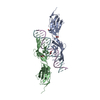

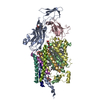

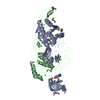
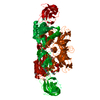

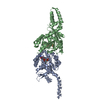
 PDBj
PDBj